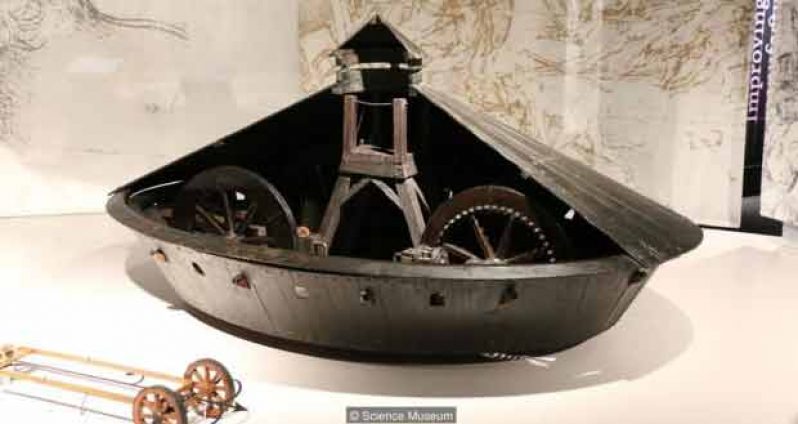
(BBC)Famed as a conspirator in The da Vinci Code and as the master painter behind the “Mona Lisa Smile”, Leonardo da Vinci was a true Renaissance man – with passions spanning geology, geometry, astronomy, mathematics, botany, pyrotechnics, optics and zoology. Among his many achievements, he was first to explain why the sky is blue and wrote the words “for every action there is an opposite and equal reaction” 200 years before Newton was born.
But his artistic talent and scientific understanding pale in comparison to a lesser-known side of this enigmatic genius: his inventions.
He is popularly, though erroneously, credited with inventing scissors. In fact many of his ideas were much, much weirder. From shoes for walking on water to a plane which resembles a giant mechanical bat, to revolving bridges which evoke the magical staircases in Harry Potter; his elaborate designs have a dream-like quality which is irresistibly compelling. After the plague devastated Milan in 1484 he even drew up plans for a utopian city.
For hundreds of years his futuristic designs lay unpublished and unread, languishing in trunks and outhouses. Some 700 pages of notes and sketches were rediscovered in the late 19th Century, but his inventions remained in obscurity until Italian dictator Benito Mussolini commissioned a series of models as part of an effort to stir up nationalist pride in 1939.
On the 500th anniversary of da Vinci’s birth in 1952, a further 39 were made in Milan, recreated using materials which would have been available to him in the 15th Century. The models are on display –among others – at London Science Museum’s exhibition Leonardo da Vinci: The Mechanics of Genius, which runs until 4 September 2016.
“At that time engineering was very practical, so Leonardo was unusual with his sketches. He really invented a new way of inventing, by combining his talent as an artist with his skill as an engineer,” says the exhibitions co-curator, Claudio Giorgione, from the Museo Nazionale della Scienza e della Tecnologia in Milan.

A prototype tank?
If many of da Vinci’s inventions were like something out of a dream, then his design for an armoured vehicle is straight out of a nightmare. Shaped like a cross between a tortoise and a spaceship, this behemoth would have been powered by eight men turning pedals by hand. Though it was never made, he envisaged a metal-plated wooden structure on wheels, with canons around the edge and slits to allow soldiers to shoot their weapons from inside.
“This is a beautiful example of the innovative way Leonardo used his technical drawings. They are much more powerful than those of his contemporaries. He represents how the tank would move over the ground with dust and speed,” says Giorgione.
The tank was commissioned by the then Duke of Milan, Ludovico Sforza, who had been charged with defending the city from invasion. “It’s one of da Vinci’s many, many hundreds of drawings of military engineering. It was a profession and a salary, so it was a very important starting point for his career here in Milan,” says Giorgione.
Intriguingly, the original design included a major defect: the front and rear wheels were geared to turn in opposite directions. If built as drawn, the vehicle would never have worked. Given the polymath’s pacifist views and clear understanding of mechanical forces, some historians believe this was no mistake, but an act of deliberate sabotage.
The metallic man
Over 500 years before C-3PO and the invention of artificial intelligence or computers, da Vinci created the ‘robotic knight’, a humanoid robot able to wave its arms, sit down and even open and close its mouth.
By studying the anatomy of human corpses, da Vinci taught himself how muscles and joints work together to move bones. His mechanical doll was designed to mimic these processes using a system of pulleys, gears and cables operated by a hand crank.
Da Vinci’s robots were mostly for the entertainment of his wealthier patrons, such as the automatic lion he invented for the king of France. The knight was mostly used for theatrical displays at parties thrown by Sforza.
“His work with special effects is one of the few moments where his studies in engineering were really known to his contemporaries. Most of these drawings were kept in his private diaries,” says Giorgione.
Little did da Vinci know, later his designs would be resurrected and incorporated into Nasa’s Anthrobot, a highly dexterous, anatomically correct robot hand currently used to carry out tasks requiring nimble fingers on Mars.
Historical helicopter
Long before engines, Perspex windows or strong-but-light aluminium alloys, this vertical take-off flying machine was truly ahead of its time. Made of stretched linen “sails” and wooden masts, it may be more reminiscent of a circular sailing ship than a modern helicopter, but the invention demonstrates da Vinci’s grasp of physical laws which wouldn’t be formally discovered for centuries.
“This is an incredible drawing, unique from all the others. The drawing is described very carefully by Leonardo with a note talking about how he had made little paper models,” says Giorgione.
The “aerial screw” is thought to have been inspired by watching the spiralling descent of the seeds of the maple tree; with enough rotation, da Vinci hoped the sails would bore upwards into the air. We now know it would never have worked as a flying craft. Instead he had inadvertently invented a precursor to the propeller. “He was aware it was impossible to make this design – in its current form – rotate. He had the first intuition for how propellers can work but he could not develop the idea,” says Giorgione.
With long-lost sketches turning up as late as 1966 – and the discovery of one of his paintings in 2011 – there may be more inventions out there somewhere. Who knows, he may have thought up something we haven’t invented yet.




.jpg)










